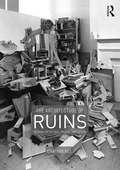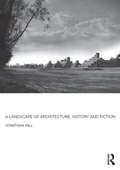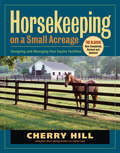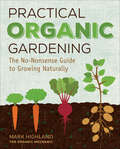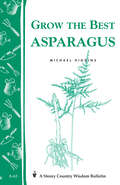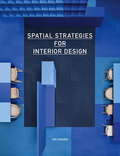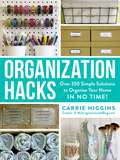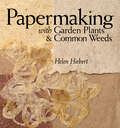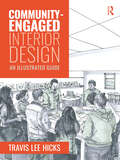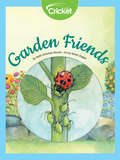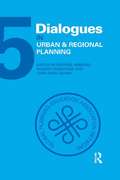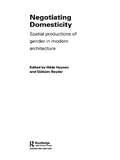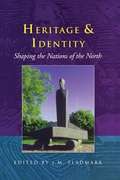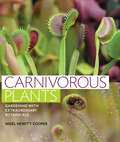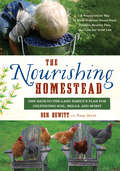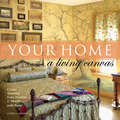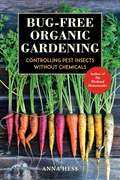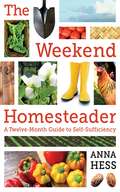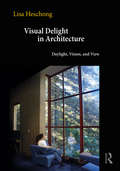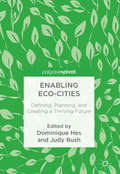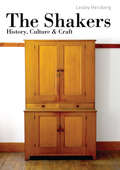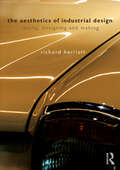- Table View
- List View
The Architecture of Ruins: Designs on the Past, Present and Future
by Jonathan HillThe Architecture of Ruins: Designs on the Past, Present and Future identifies an alternative and significant history of architecture from the sixteenth century to the twenty-first century, in which a building is designed, occupied and imagined as a ruin. This design practice conceives a monument and a ruin as creative, interdependent and simultaneous themes within a single building dialectic, addressing temporal and environmental questions in poetic, psychological and practical terms, and stimulating questions of personal and national identity, nature and culture, weather and climate, permanence and impermanence and life and death. Conceiving a building as a dialogue between a monument and a ruin intensifies the already blurred relations between the unfinished and the ruined and envisages the past, the present and the future in a single architecture. Structured around a collection of biographies, this book conceives a monument and a ruin as metaphors for a life and means to negotiate between a self and a society. Emphasising the interconnections between designers and the particular ways in which later architects learned from earlier ones, the chapters investigate an evolving, interdisciplinary design practice to show the relevance of historical understanding to design. Like a history, a design is a reinterpretation of the past that is meaningful to the present. Equally, a design is equivalent to a fiction, convincing users to suspend disbelief. We expect a history or a novel to be written in words, but they can also be delineated in drawing, cast in concrete or seeded in soil. The architect is a ‘physical novelist’ as well as a ‘physical historian’. Like building sites, ruins are full of potential. In revealing not only what is lost, but also what is incomplete, a ruin suggests the future as well as the past. As a stimulus to the imagination, a ruin’s incomplete and broken forms expand architecture’s allegorical and metaphorical capacity, indicating that a building can remain unfinished, literally and in the imagination, focusing attention on the creativity of users as well as architects. Emphasising the symbiotic relations between nature and culture, a building designed, occupied and imagined as a ruin acknowledges the coproduction of multiple authors, whether human, non-human or atmospheric, and is an appropriate model for architecture in an era of increasing climate change.
A Landscape of Architecture, History and Fiction
by Jonathan HillArchitecture can be analogous to a history, a fiction, and a landscape. We expect a history or a novel to be written in words, but they can also be cast in concrete or seeded in soil. The catalyst to this tradition was the simultaneous and interdependent emergence in the eighteenth century of new art forms: the picturesque landscape, the analytical history, and the English novel. Each of them instigated a creative and questioning response to empiricism’s detailed investigation of subjective experience and the natural world, and together they stimulated a design practice and lyrical environmentalism that profoundly influenced subsequent centuries. Associating the changing natural world with journeys in self-understanding, and the design process with a visual and spatial autobiography, this book describes journeys between London and the North Sea in successive centuries, analysing an enduring and evolving tradition from the picturesque and romanticism to modernism. Creative architects have often looked to the past to understand the present and imagine the future. Twenty-first-century architects need to appreciate the shock of the old as well as the shock of the new.
Horsekeeping on a Small Acreage: Designing and Managing Your Equine Facilities
by Cherry HillKeeping your own horses requires dedication, hard work, and a sincere interest in the well-being of your animals. This practical guide shows you how to design efficient facilities and establish effective maintenance routines so that your horses can stay happy, healthy, and safe on even the smallest plots of land. Offering expert advice on barn designs, fencing options, and pasture management, Cherry Hill stresses the importance of understanding horse behavior and environmentally responsible land stewardship as integral aspects of a pleasurable and rewarding horsekeeping experience.
Practical Organic Gardening: The No-Nonsense Guide to Growing Naturally
by Mark HighlandGet your hands dirty in the garden! Practical Organic Gardening is a comprehensive guide to organic gardening practices that focuses on hands-on, up-to-date information and high-quality visual information.Practical Organic Gardening sprouts homegrown, healthy edibles and other safe plants that are nourishing and tasty for your family, pets, and beneficial wildlife. Organic gardening isn't just for environmentalists anymore. Over the last several years it has been a popular gardening method. Believe it or not, it organic gardening has actually been around for most of the last century, but interest in organic gardening has soared in recent years as gardeners have become more aware of the quality of their food. Now is your chance to learn with this comprehensive book. Written by Mark Highland, founder of The Organic Mechanic, this is far from a hippie manifesto; it is a scientifically driven, modern-day dive into the organic methods, products, and practices that will appeal to any home gardener looking to make the transition from conventional to organic.
Grow the Best Asparagus: Storey's Country Wisdom Bulletin A-63
by Michael HigginsSince 1973, Storey's Country Wisdom Bulletins have offered practical, hands-on instructions designed to help readers master dozens of country living skills quickly and easily. There are now more than 170 titles in this series, and their remarkable popularity reflects the common desire of country and city dwellers alike to cultivate personal independence in everyday life.
Spatial Strategies for Interior Design
by Ian HigginsThis inspirational and practical guide to organizing and planning interior spaces is packed with photographs, diagrams, models, case studies, and step-by-step instructions. It provides useful information on finding ways to start the design process, analyzing existing buildings, using planning diagrams, developing three-dimensional spatial compositions, designing in section, how to communicate your design ideas, and much more.
Spatial Strategies for Interior Design
by Ian HigginsThis inspirational and practical guide to organizing and planning interior spaces is packed with photographs, diagrams, models, case studies, and step-by-step instructions. It provides useful information on finding ways to start the design process, analyzing existing buildings, using planning diagrams, developing three-dimensional spatial compositions, designing in section, how to communicate your design ideas, and much more.
Organization Hacks: Over 350 Simple Solutions to Organize Your Home in No Time! (Hacks)
by Carrie HigginsFix your cluttered cabinets, overflowing drawers, and messy living areas with these tips, tricks, and project ideas from Carrie Higgins, the organization expert of the Making Lemonade blog.Carrie Higgins has made it her mission to share fresh ideas for the home on her blog Making Lemonade. In this guide she has collected her best quick fixes, innovative hacks, and DIY solutions to keep your home looking beautiful, such as: -Using a ladder and a collection of S-hooks for additional pots and pans storage -Attaching a binder clip to your nightstand for your phone charger so the end never falls under the bed again -Using daylight saving time as a reminder to check the expiration date on the medications in your cabinet. And some of her more in-depth projects include: -DIY magnetic spice jars to keep spices on your fridge and near at hand -Easy-attach baskets for storing bath toys for the little ones -A foolproof travel packing grid for quick and easy getaways With Organization Hacks, you can get your house in order and turn your home from a hoarding nightmare into a clutter-free paradise!
The Papermaker's Companion: The Ultimate Guide to Making and Using Handmade Paper
by Helen HiebertCraft your own colorful paper goods and personalized stationary. With clear, step-by-step instructions, Helen Heibert covers all aspects of the papermaking process — from growing and harvesting plants for a malleable paper pulp to embellishment techniques like dyeing, embossing, and laminating. With tips on building your own papermaking equipment, ideas for transforming junk mail into dazzlingly unique notecards, and much more, you’ll be inspired to let your creativity shine as you explore the endless possibilities of handcrafted papers.
Papermaking with Garden Plants & Common Weeds
by Helen HiebertMake exquisite papers right in your own kitchen. With a few pieces of basic equipment and a small harvest of backyard weeds, you can easily create stunningly original handcrafted papers. Helen Heibert&’s illustrated step-by-step instructions show you how easy it is to blend and shape a variety of organic fibers into professional stationery, specialty books, and personalized gifts. You&’ll soon be creatively integrating plant stalks, bark, flower petals, pine needles, and more to add unique colors and textures to your paper creations. This publication conforms to the EPUB Accessibility specification at WCAG 2.0 Level AA.
Community-Engaged Interior Design: An Illustrated Guide
by Travis Lee HicksThis step-by-step guide takes the reader through each stage of the design process, from concept to completion, exploring practical methods of how to engage the community throughout interior architecture and design projects. This book argues that all design should be accomplished through a process of engagement, be it with community members, clients, or end users. The community-engaged designer welcomes participatory processes, mutually beneficial collaboration, and equitable inclusion in order to meet the needs and wants of diverse groups of people. Chapters cover the initial engagement of communities, marketing, and pre-design phases, translating research into a design scheme in development with the community, communicating designs, engaging community-based makers, craftspeople, product manufacturers, vendors, and distributors, constructing designs, and evaluating the end result. Finally, case studies of successful community-engaged design projects are presented and analyzed to demonstrate this approach in action. Learning objectives, chapter summaries, and exercises help to ease understanding and build design thinking and technical skills, equipping the reader with the tools to succeed as a community-engaged designer. Hicks distills years of experience teaching community-engaged design within this volume, which will be a valuable resource for all interior architecture and design students and practitioners.
Garden Friends
by Faith HickmanGardens make great habitats for many types of animals. Water, protection and food are the benefits for animals living in a garden, and in return they keep the soil healthy, eat pesky insects, and help pollinate the flowers. Ladybugs are helpful to a garden–they eat insects called aphids. Find out which animals are a gardener’s best friends and which are enemies!
Dialogues in Urban and Regional Planning: Volume 5
by Michael Hibbard Robert Freestone Tore Øivin SagerDialogues in Urban and Regional Planning 5 is a selection of some of the best scholarship in urban and regional planning from around the world. The internationally recognized authors of these award-winning papers take up a range of salient issues from the theory and practice of planning. The topics they address include the effects of globalization on world cities, metropolitan planning in France and Australia, and new research in pedestrian and traffic design. The breadth of the topics covered in this book will appeal to all those with an interest in urban and regional planning, providing a springboard for further debate and research. The papers focus particularly on themes of inclusion, urban transformation, metropolitan planning, and urban design. The Dialogues in Urban and Regional Planning (DURP) book series is published in association with the Global Planning Education Association Network (GPEAN) and its member national and transnational planning schools associations.
Negotiating Domesticity: Spatial Productions of Gender in Modern Architecture
by Hilde Heynen Gülsüm BaydarIn the home the intricate relations between architecture, gender and domesticity become visible. Negotiating Domesticity investigates the many and complex themes evoked by the interconnections between these terms. Topics covered include famous as well as less well-known architectural examples and architects, which are explored from sociological, anthropological, philosophical and psychoanalytical approaches. The authors explore the relationships between modern domestic spaces and sexed subjectivities in a broad range of geographical locations of Western modernity. This richly interdisiplinary work presents architects and postgraduate students with an in-depth exploration of domesticity in the modern era.
Heritage and Identity
by Thor Heyerdahl J. M. FladmarkWas the shaping of nation states in Northern Europe governed by military might, or by Christian and democratic ideals? How has trade and cross-cultural exchange between Scandinavia and the British Isles shaped our historic identities, and what about the impact of global politics and marketing in recent times? These are some of the questions explored by the contributors in the context of forces that shape national identities today. Their analysis highlights the need for historical awareness when developing future cultural policy, brand profiles and marketing strategies. Looking back, Jesse Byock tells how democracy was first embraced in the north by the early settlers of Iceland, Bjorn Myhre delves into the unpredictability of historical interpretation, Edward Cowan discusses the role of 'battles and beddings' in relations across the North Sea, John Purkis writes about William Morris' fascination with Nordic culture, Stephen Harrison presents the 'winning ways' of product development and marketing by Manx National Heritage, whilst Chris Powell looks at 'Cool Britannia' today and Simon Anholt at national branding strategies. This is an inspirational book that sheds new light on old subjects, equally relevant for both public and private sector policy makers alike.
Carnivorous Plants: Gardening with Extraordinary Botanicals
by Nigel Hewitt-CooperOnce known only to collectors, adolescent boys, and fans of the cult film The Little Shop of Horrors, carnivorous plants are poised to be the next big trend in home gardening. They provide striking architectural style and can be grown indoors and outdoors. Carnivorous Plants is an accessible, smartly designed guide to growing this unusual group of plants. It offers a general introduction to the world of carnivorous plants, and growing and cultivation information for commonly available and easily grown varieties. Nigel Hewitt-Cooper also provides advice on where to grow the plants; year-round care, cultivation, and maintenance; and a directory of the best carnivorous plants for home gardeners.
The Nourishing Homestead
by Penny Hewitt Ben HewittA practiculture way to grow nutrient-dense food, produce healthy fats, and live the good life The Nourishing Homestead tells the story of how we can create truly satisfying, permanent, nourished relationships to the land, nature, and one another. The Hewitts offer practical ways to grow nutrient-dense food on a small plot of land, and think about your farm, homestead, or home as an ecosystem. Much of what the Hewitts have come to understand and embrace about their lives of deep nourishment is informed by their particular piece of land and local community in northern Vermont, but what they have gleaned is readily transferable to any place--whether you live on 4 acres, 40 acres, or in a 400-square-foot studio apartment. Ben and Penny (and their two sons) maintain copious gardens, dozens of fruit and nut trees and other perennial plantings, as well as a pick-your-own blueberry patch. In addition to these cultivated food crops, they also forage for wild edibles, process their own meat, make their own butter, and ferment, dry, and can their own vegetables. Their focus is to produce nutrient-dense foods from vibrant, mineralized soils for themselves and their immediate community. They are also committed to sharing the traditional skills that support their family, helping them be self-sufficient and thrive in these uncertain times. Much of what the Hewitts are attempting on their homestead is to close the gaps that economic separation has created in our health, spirit, and skills. Ben uses the term "practiculture" to describe his family's work with the land--a term that encompasses the many practical life skills and philosophies they embody to create a thriving homestead, including raw-milk production, soil remediation, wildcrafting, Weston A. Price principles, bionutrient-dense farming, permaculture, agroforestry, traditional Vermont hill farming, and more. The Nourishing Homestead also includes information on deep nutrition, the importance of good fats, and integrating children into the work of a homestead. The Hewitts' story is reminiscent of The Good Life, by Helen and Scott Nearing, and is sure to inspire a new generation of homesteaders, or anyone seeking a simpler way of life and a deeper connection to the world.
Your Home - A Living Canvas: Create Fabulous Faux Finishes and Amazing Murals with Paint
by Curtis HeuserUncover the glory in your home! Use paint to create inspired living spaces that reflect your style and your home's character.Once upon a time, there was a sad little Victorian house on the corner, abandoned by its previous owners and abused by time. Your Home, A Living Canvas is the Cinderella story of that house and its transformation into a charming, historic home, thanks to the loving care of acclaimed decorative artisan, Curtis L. Heuser.From the grand staircase to the cozy third-floor master suite, this book takes you along on the complete floor-to-ceiling, room-by-room makeover. You'll learn about the design concepts and inspirations for each space, along with real-world how-to's behind the wall treatments, ceiling features, architectural highlights, and other exquisite details.A series of 25+ step-by-step demonstrations show how Heuser used murals, trompe l'oeil and faux finishes to blend old with new, reclaiming the spirit of the house's former glory, while incorporating unique personal touches.Covers a range of decorative styles, from the exotic crackle-finish bookcases in the study, to the Italian country villa-inspired kitchen, to a sophisticated dining room that embodies the Old World ambiance of classic European interiors.Offers a wealth of expert decorating advice on using color to evoke mood, displaying your collections, mixing and matching eclectic furnishings, and more.Whether you're interested in a simple faux finish technique or are dedicated to preserving the architecture and charm of your own historic dwelling, this book will help you create a living environment rich in color, texture and atmosphere ... a place called "home."
Bug-Free Organic Gardening: Controlling Pest Insects Without Chemicals
by Anna HessPut down those harmful sprays and learn natural pest control! Are you sick and tired of pesky insects in your garden? Do you want to stay away from pesticides and harmful poisons that could be hazardous to your health and your garden? If you answered yes to both of those questions, Bug-Free Organic Gardening has all the answers to your troubles. This book will show you how to bring your garden ecosystem into balance so that beneficial insects and larger animals do the work of pest control for you. Anna Hess has more than a decade’s experience growing all of her family’s vegetables. Here, she sums up all of her knowledge and expertise, teaching you many hands-on pest-control techniques, such as: Succession plantingChoosing resistant plant varietiesShielding plants with row coversTiming plantings to bypass bugsAnd so much more! With Anna’s expertise, you too can grow beautiful, healthy, organic vegetables for yourself and your family, put down those harmful sprays, and learn natural pest control!
The Weekend Homesteader: A Twelve-Month Guide to Self-Sufficiency
by Anna HessThe Weekend Homesteader is organized by month--so whether it's January or June you'll find exciting, short projects that you can use to dip your toes into the vast ocean of homesteading without getting overwhelmed. If you need to fit homesteading into a few hours each weekend and would like to have fun while doing it, these projects will be right up your alley, whether you live on a forty-acre farm, a postage-stamp lawn in suburbia, or a high rise. You'll learn about backyard chicken care, how to choose the best mushroom and berry species, and why and how to plant a no-till garden that heals the soil while providing nutritious food. Permaculture techniques will turn your homestead into a vibrant ecosystem and attract native pollinators while converting our society's waste into high-quality compost and mulch. Meanwhile, enjoy the fruits of your labor right away as you learn the basics of cooking and eating seasonally, then preserve homegrown produce for later by drying, canning, freezing, or simply filling your kitchen cabinets with storage vegetables. As you become more self-sufficient, you'll save seeds, prepare for power outages, and tear yourself away from a full-time job, while building a supportive and like-minded community. You won't be completely eliminating your reliance on the grocery store, but you will be plucking low-hanging (and delicious!) fruits out of your own garden by the time all forty-eight projects are complete.
Visual Delight in Architecture: Daylight, Vision, and View
by Lisa HeschongVisual Delight in Architecture examines the many ways that our lives are enriched by the presence of natural daylight and window views within our buildings. It makes a compelling case that daily exposure to the rhythms of daylight is essential to our health and well-being, tied to the very genetic foundations of our physiology and cognitive function. It describes all the subtlety, beauty, and pleasures of well-daylit spaces and attractive window views, and explains how these are woven into the fabric of both our everyday sensory experience and enduring cultural perspectives. All types of environmental designers, along with anyone interested in human health and well- being, will fi nd new insights offered by Visual Delight in Architecture. The book is both accessible and provocative, full of personal stories and persuasive research, helping designers to gain a deeper understanding of the scientific basis of their designs, scientists to better grasp the real-world implications of their work, and everyone to more fully appreciate the role of windows in their lives.
Enabling Eco-Cities
by Dominique Hes Judy BushCities are striving to become more resilient, adaptive and sustainable; this requires new ways of governing and developing the city. This book features chapters by researchers using regenerative development and transitions theories to envisage how Eco-Cities could be planned, designed and created, and concludes with practical tools and an outline of how this evolution could be facilitated. It examines two major questions: How can we use understandings of Eco-Cities to address the legacy of urban built form and existing practices which often make it difficult to create the systemic changes needed? And what are the elements of complex urban places and spaces that will enable the planning, creation and evolution of thriving cities?The book will appeal to planners, city makers, urban researchers, students and practitioners, including planners, designers, architects and sustainability managers, and all those seeking to envisage the steps along the path to thriving cities of the future.
The Shakers
by Lesley HerzbergLeaving Manchester, England, in 1774 to avoid religious persecution, the Shakers crossed the Atlantic and during the next 50 years established 19 villages in the United States from Maine to Kentucky. Guided by the principles of utility, honesty, and order, the ultimate goal of the Shakers was to create a heaven on earth in both their worship and their work. Consequently, careful craftsmanship, signature details, an dthe commitment to excellence are seen in every object they produced, ranging from free-standing tables, chairs, desks, boxes, and case clocks to built-in cupboards and cases of drawers. The unique buildings, objects, and lifestyle of the Shakers has set them apart in American art and culture as a matter of course, but ever since "Shaker Handicraft" - the first major Shaker exhibition at the Whitney Museum of American Art in 1935 --the appreciation for Americana and folk art has continued to grow. Today the spirit of Shaker craft, combined with its clean lines, solid construction, and honest functionality, make it one of the most popular and timeless design categories in the US and beyond.From the Trade Paperback edition.
The Aesthetics of Industrial Design: Seeing, Designing and Making
by Richard HerriottThis textbook introduces design students to key principles of three-dimensional form, bridging aesthetics and practical design objectives. It explores how we see and what it is that characterises visually appealing and satisfactory design. Written by an experienced designer, educator and researcher, The Aesthetics of Industrial Design equips students with the knowledge and understanding of how aesthetically superior design is distinct from lesser work. It explains the key principles and concepts they can incorporate into their own designs, encourages readers to investigate and experiment with real design problems and enables them to verbally communicate their design intentions. The book prompts readers to critically reflect on their work and surroundings. Through numerous clear examples and illustrated case studies, which are guided by cognitive science and the application of aesthetic theory, the book brings together the basic aspects of design as form-giving. It explores the balance of function, material and appearance in detail and explains the reasons for common aesthetic faults and how to avoid them. Aimed at undergraduate- and postgraduate-level students within the design fields, this book reveals the secrets to aesthetically successful products that readers can take from education into future practice.
